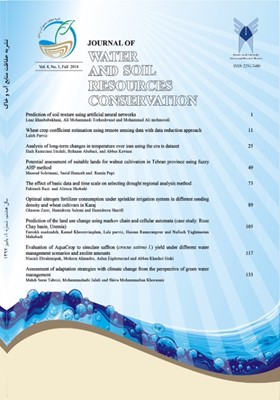The effect of basic data and time scale on selecting drought regional analysis method
Subject Areas : Farm water management with the aim of improving irrigation management indicators
Fahimeh Razi
1
,
Alireza Shokoohi
2
![]()
1 - Water Engineering Department, Faculty of Engineering and Technology, Imam Khomeini International University
2 - عضو هیئت علمی دانشگاه بین المللی امام خمینی (ره)، دانشکده فنی و مهندسی، گروه مهندسی آب
Keywords: K-means, cluster analysis, SPI, Anzali wetland watershed, L-moment,
Abstract :
One important issue in drought studies is realizing the spatial pattern of drought events in a region through point estimation of the drought characteristics. In the first section of this research, in order to investigate the effect of probability distribution function transformation embedded in SPI, on the spatial distribution of drought, regional analysis was carried out using precipitation and SPI data, separately. The case study is the Anzali wetland watershed in the north of Iran. The results in terms of the employed regional analysis method and time scale were different. The results showed that by decreasing the time scales to less than 1 year, while by the SPI index the region was completely homogeneous, the region was divided into different sub-regions using precipitation. The important conclusion drawn from this part of the research was the necessity of zoning the region via precipitation and then analyzing drought in the obtained regions. In the second part of the research, a comparison was made among three zoning methods including; L-moment, hierarchical and non-hierarchical clustering methods using precipitation and SPI, separately. Overall, L-moment was more successful than the other two clustering methods in detecting homogeneous regions in the study area. Finally, it was concluded that reducing events time scales sharpened the difference between the zoning methods; therefore, choosing an appropriate zoning method would be more important in monthly and seasonal time resolutions.
_||_


